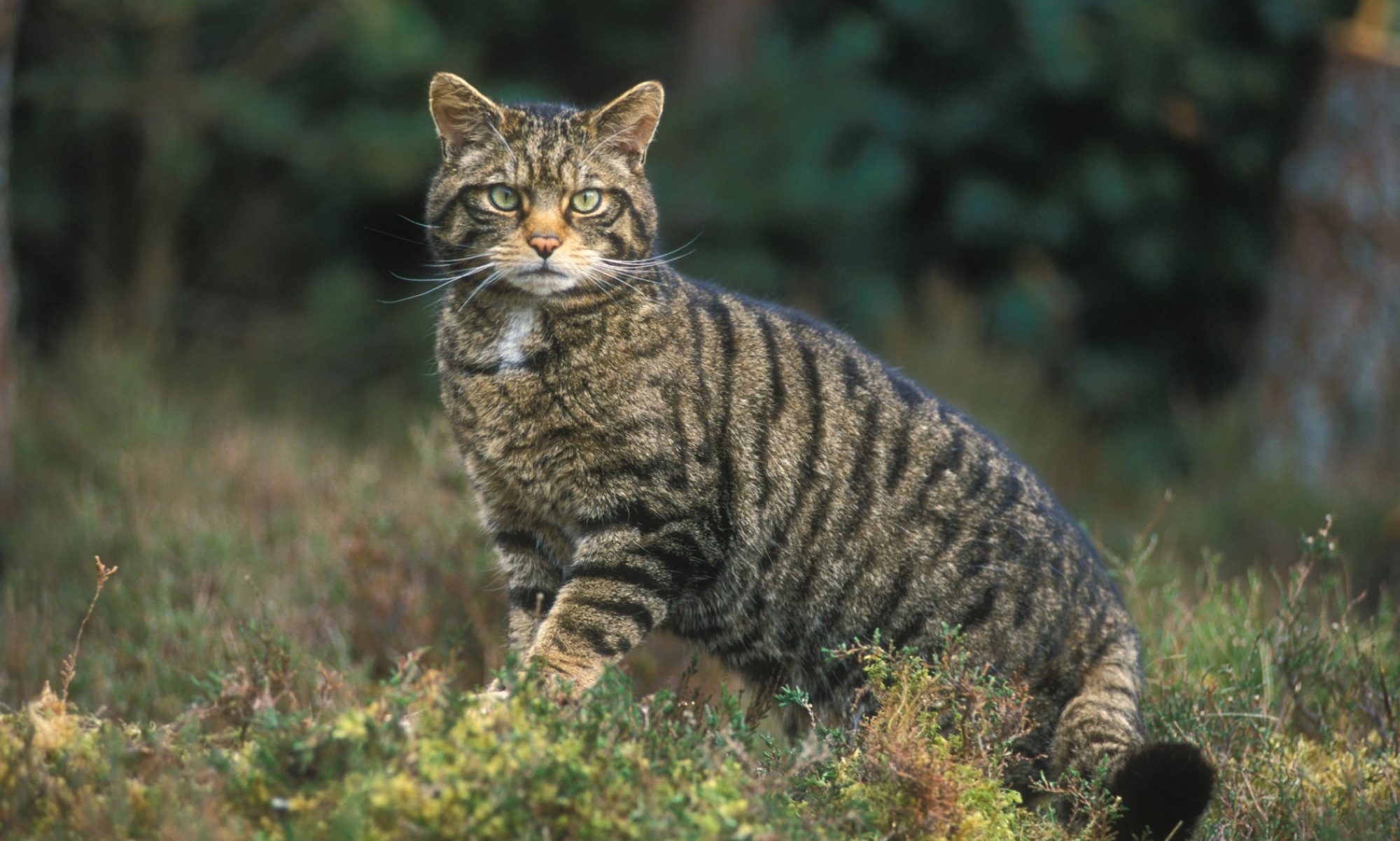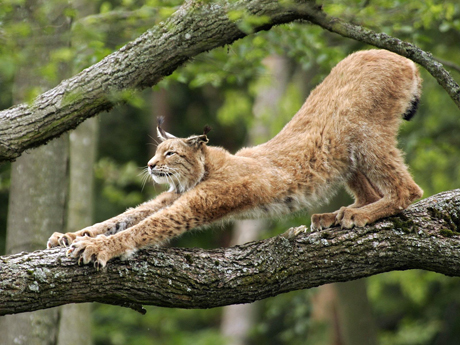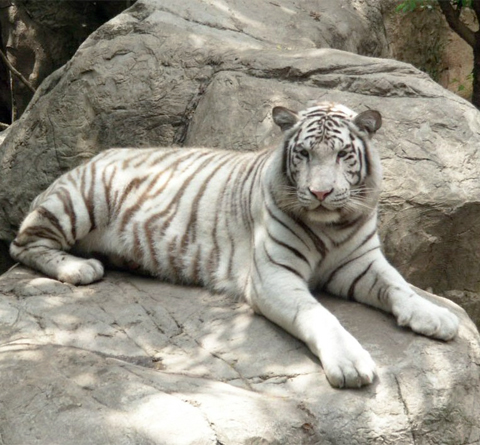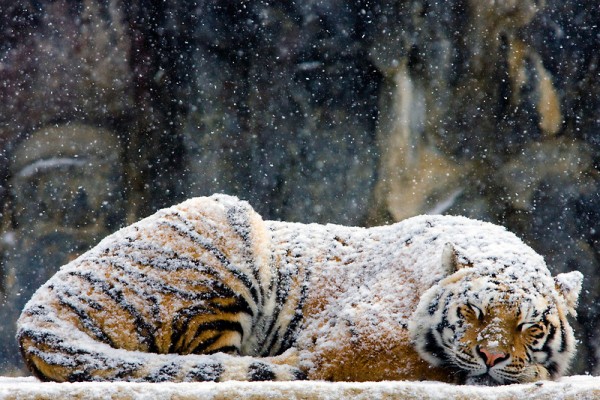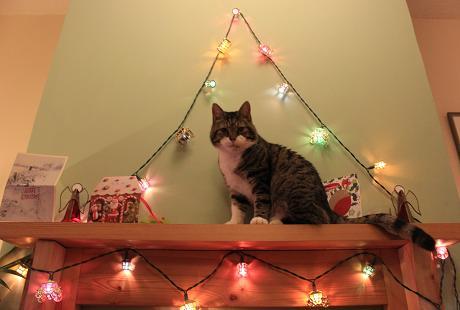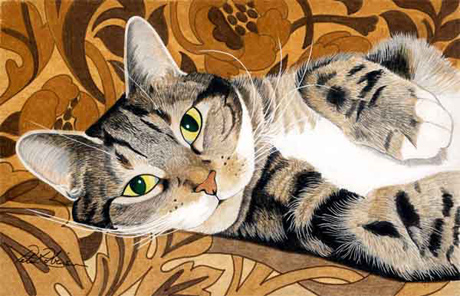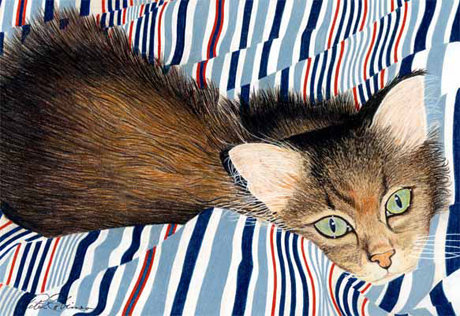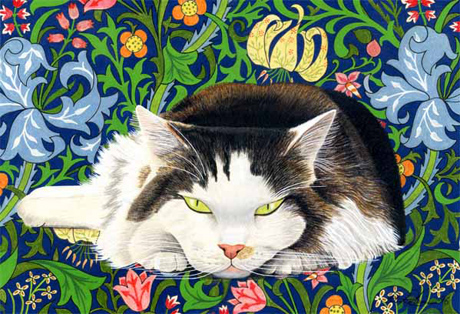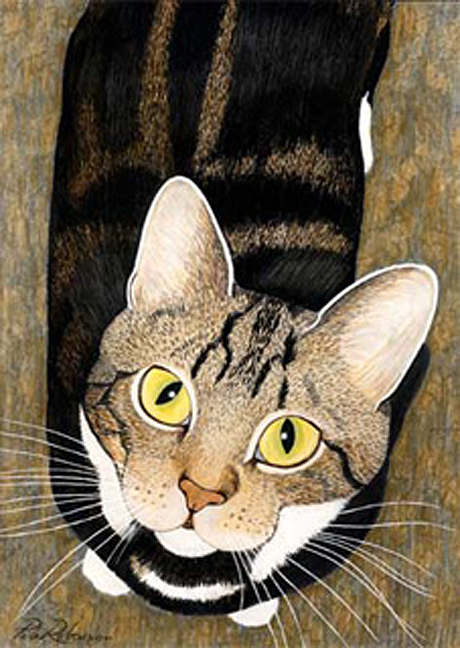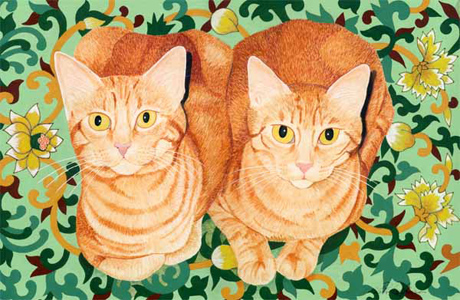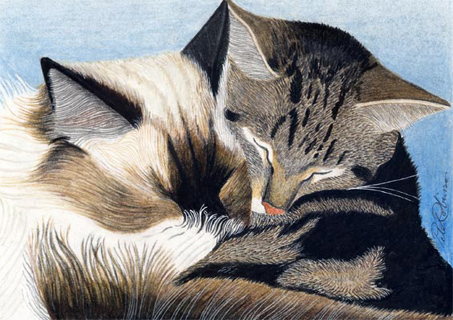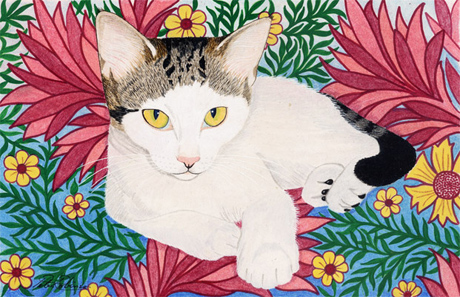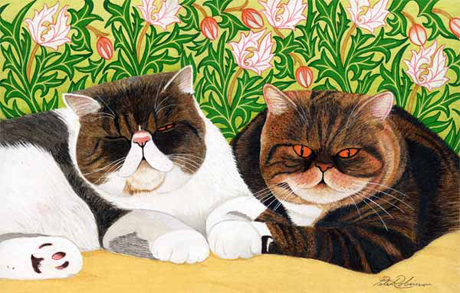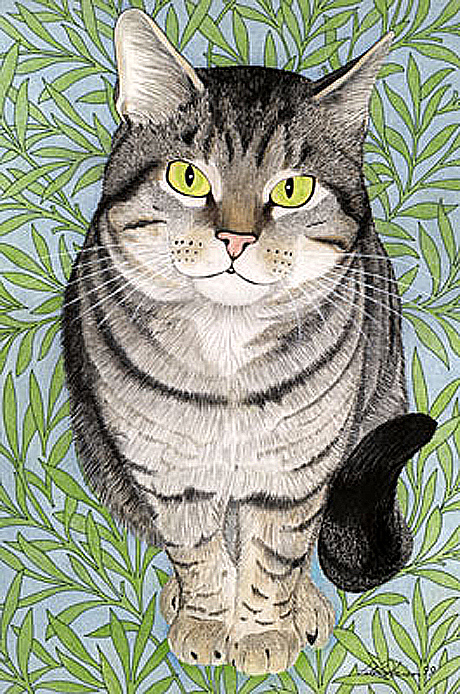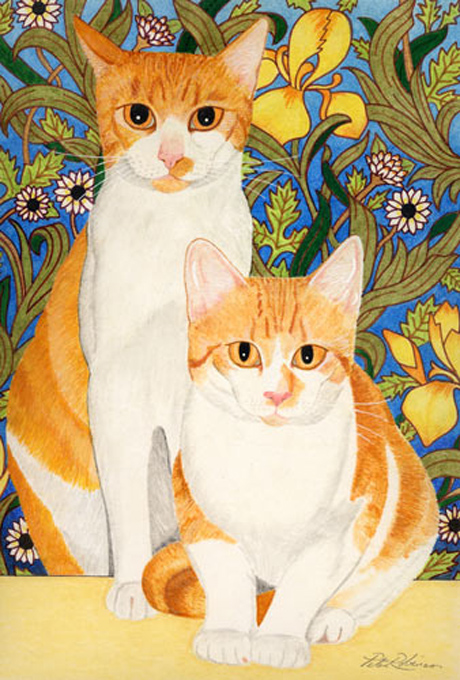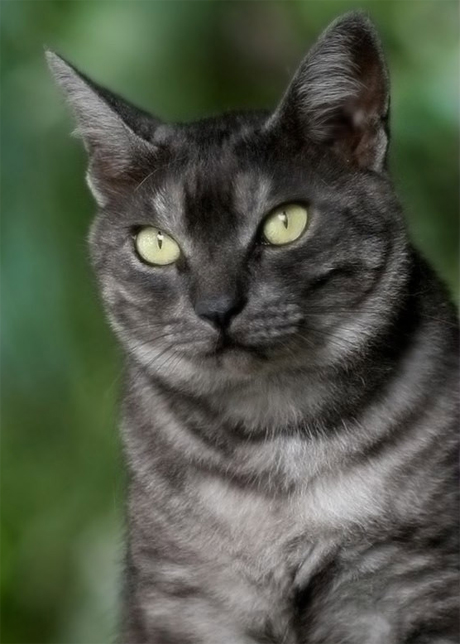White Tiger
Cat of the Month ~ January 2012
White tigers are basically a colour variant of the Bengal tiger (Panthera tigris bengalensis), and are rarely found in the wild. It is though, reported as having been seen in the wild from time to time in the Assam, Bengal, and Bihar regions of India and especially from the former State of Rewa (in fact home to the very first white tiger). It is believed that all white tigers in captivity in the world today are the descendants of this single white tiger, caught (and named ‘Mohan’) by the Maharajah of Rewa in the year 1951.
The White Tiger is almost identical to the now famous Royal Bengal Tiger except for a genetic mutation that causes a change in the colour of the fur and eyes. The origin of the Bengal Tiger is believed to be from the region we know today as Siberia. From there, these Siberian Big Cats (Panthera tigris altaica) migrated south over the course of thousands of years (and as the climate of their native territory became colder). Today Asia, India and Malaysia all are home to tigers (some of which are white due to genetic mutation), although their numbers are dwindling.
White tigers are only born when two tigers that both carry the unusual gene for white colouring, mate. Unfortunately there are many forced breeding programs currently in progress which are detrimental to those tigers bred in captivity. This is indeed often a sad tale which is outlined in the following very serious and informative article [White Tigers – Conserving Misery]. (Not for the very young or easily upset, Ed)
Where present, white (and other) Bengal tigers will be found regions of dense undergrowth and forested areas where they can camouflage themselves and ambush their prey.
Though, today white tigers are mostly confined in zoos (for example the Nandan Kanan Zoo in Orissa, India) they are also found in many National parks, such as those in India and the Far East.
Tiger in snowfall
Norman’s Christmas Message 2011
Seasons Greetings reader, whether you are cat, kitten, creature or human.
I hope you had a lovely calm and peaceful year and have an equally peaceful 2012.
Ahem miaow. I myself had a fairly uneventful time of it except for my run in with a veterinary dentist who had the audacity and wherewithal to extract my left rear molar without my consent (and very painful it was too). That, and of course my enforced summer stay in the local cattery (always a low point of my year)! Other than that I had a marvelous time, mainly sleeping but occasionally getting up to chase a bird, mouse or small human around the garden.
Enough of me already! This season of the year is (as always) a time for us all, to think about one another, and for yours truly this means meditating on the sad plight of the tigers, lions and all the human hunted cats of this world. Also, consider (as I do) the unwanted street cats and the waifs & strays of our cities and the hardships they have to endure.
So I urge you dear reader to, reassess your priorities and to visit your local cat (or dog) sanctuary in the new year and, if you can, fit another ball of fur, claws and teeth (ouch) and sheer feline/canine delight into your clan, please do so.
As for our bigger cousins, let those with the means, help as much as they can. For the rest of us we will have to pray that the hunters realise the error of their ways in this coming year.
A very merry Christmas, good health and kind fortune to you all,
All my love, sincerely,
Norm
x x x
Santa Claws
Here’s one for the festive season, reader.
Cat paintings by Peter Robinson
We’ve been looking at these painting for many years (haven’t we Norm?) and find them fascinating. I’m including a selection of our favourites here. We especially like the one that’s a dead ringer for Norman himself! We’d like to thank Peter (Gordon and the all the cats too!) for letting us post them here.
Peters work is described on his own website …”Working in designer gouache and pastels, mostly from photographs, Peter paints his cats with colourful, intricate and detailed backgrounds”. To us, Peter seems to capture the real spirit of these cats, as well as making the works highly decorative. Wonderful!
Munchkin
Cat of the Month ~ November 2011
Munchkin cats are a controversial breed. Munchkins have a naturally occurring genetic mutation that results in them having legs which are unusually short… but the question many have asked is “is it ethical to go on breeding these mutant cats”.
It is said that the ‘short leg’ gene of the Munchkin is similar to the gene which gives Basset Hound, Corgi and Dachshund dogs their short stature (the little ‘Scottish Fold’ cats also have this gene). Munchkins though, do not suffer from the many spinal problems that these dogs are prone to. Studies have shown that the spine of a Munchkin cat is very rarely different from that of other cats. So perhaps it is not such a bad thing that they are bred for their small size.
Long before the name ‘Munchkin’ was first used, there had been sightings of these short-legged cats the world over. For example, a large breeding population had been observed in Europe throughout the early part twentieth century. This group had though all but died out by 1950.
It was in 1964 that a solitary cat of the Munchkin breed was first documented in the United States by Ellen Kasten in the town of Westbury, New York, but it was not until 1983 when a music teacher in Louisiana found two pregnant cats (one of which had a litter of short-legged kittens!) that the Munchkin ‘line’ was truly begun.
It took another eight years before the Munchkin was first introduced to the general public. In 1991 a national network televised cat show held by The International Cat Association in Madison Square Garden presented several Munchkins to the adoring public. It was not all roses though as there was much controversy when TICA went on to accept the Munchkin into its New Breed development program in September 1994. Critics predicted that the breed would develop back, hip and leg problems.
In fact studies at the time proved that the Munchkin was a physically sound cat. At the time one veteran show judge resigned in protest, calling the breed an affront to all breeders with ethics. However the Munchkin achieved TICA Championship status in May 2003 (go Munchkin!).
The Munchkin is generally described as a sweet-natured, playful, people-oriented, outgoing and intelligent cat which responds well to being handled. As pets they are very playful and certainly don’t let their shorter legs hinder them from running, jumping and climbing, just like other cats do.
Munchkins are small to medium sized cats with a moderate “semi-foreign” body type. A male Munchkin typically weighs between 3 to 4 kg and is usually larger than a female, which typically weighs between 1 to 3.5 kg. The short legs of the Munchkin may be slightly bowed or cow-hocked (which render these animals of poor show quality). Also, the hind legs can be slightly longer than the front, but these have no noticeable adverse affect on the animal. According to the Animal Planet TV show there are three types of legs on Munchkins: standard, super-short, and ‘rug hugger’.
For TICA cat shows, they are separated by fur length into two groups: The Munchkin and Munchkin Longhair. The short-haired variety has a medium-plush coat while the Long-haired has a semi-long silky coat. The Munchkin comes in many colours and coat patterns. This variety stems from the adoption of the ‘outcross’ program, across the breeding participants. This allows Munchkins to be bred with many domestic cats that don’t already belong to a recognised breed.
So, Munchkins are a healthy and hearty cat that in general suffer from the same common health problems as other cats. Some proof of this was provided In 1995, when several Breeders had their oldest Munchkins X-rayed and examined for signs of joint or bone problems. No problems were found!
The Munchkin controversy
There is controversy among breeders of pedigree cats as to whether (and if so) what genetic mutations are abnormal and potentially disadvantageous to the cat. The Australian Capital Territory (a territory of Australia) government consider the Munchkin breed to be “malformed animals” and the deliberate breeding of them “unacceptable” because of the “genetic health problems associated with such breeding”. Owners and Breeders of Munchkins declare them to be “a sound breed” that is “ideal” for small homes and not particularly susceptible to health problems.
Several cat registries do not recognise the Munchkin: Federation Internationale Feline, which refuses to recognise what they consider a breed based on a genetic disease. The Governing Council of the Cat Fancy likewise refuses to recognise the breed, considering this breed and others like it to be “unacceptable” because they are based on an “abnormal structure or development”. The breed is also not recognised by the Cat Fanciers’ Association.
Apart from TICA, registries that recognize the breed includes The American Association of Cat Enthusiasts, UK’s United Feline Organization, the Southern Africa Cat Council, the Waratah National Cat Alliance in Australia and Catz Incorporated in New Zealand.
It is interesting that despite incompatibly issues when inter-breeding Munchkin cats (leading to none Munchkin cat traits in many of the offspring), there have nevertheless been some amazing cross bred animals. These are just some of the cross ‘breeds’ that have been produced:
- The Skookum cat is a Munchkin cross with the curly coated LaPerm
- The Minskin cat is a Munchkin cross with the smooth coated hairless Sphynx.
- The Lambkin cat is a Munchkin cross with the ‘kiss’ curly coated Selkirk Rex
- The Napoleon cat is a Munchkin cross with the Persian
- The Genetta is a Munchkin cross with the Bengal
By the way, Munchkins were named after the little people in the ‘Wizard of Oz’. But we guess you guessed that already…
But did you know that ‘The Wonderful Wizard of Oz’ was written by L. Frank Baum in April 1900 (I just looked it up). Now you remember Dorothys companion the dog ‘Toto’,but theres a little known cat in the story too….
DOROTHY
Aunt Em, Miss Gulch hit Toto right over the
back with a rake just because she says he
gets in her garden and chases her nasty old
cat every day.
AUNT EM
Seventy -- Dorothy, please!
DOROTHY
Oh, but he doesn't do it every day -- just
once or twice a week. And he can't catch
her old cat, anyway. And now she says she's
gonna get the sheriff, and --
AUNT EM
Dorothy! Dorothy! We're busy!
DOROTHY
Oh -- all right.
